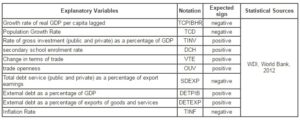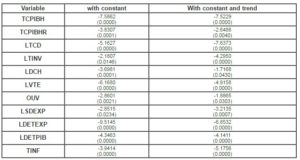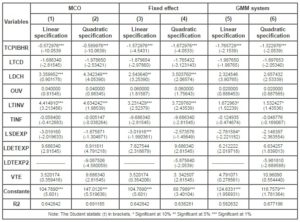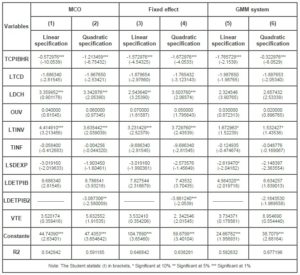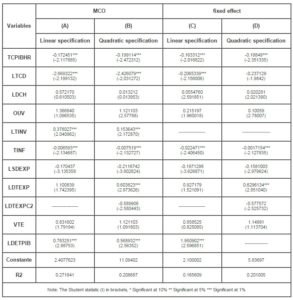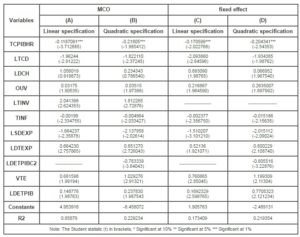References
Adam, C. S. and D. L. Bevan (2005), “Fiscal deficits and growth in developing countries”, Journal of Public Economics, 4, 571-597.
Publisher – Google Scholar
Agenor, P.R. and Montiel P., 1996. Development Macroeconomics, Princeton, New Jersey: Princeton University Pres.
Ardagna, S., F. Caselli and T. Lane (2007) “Fiscal Discipline and the Cost of Public Debt Service: Some Estimates for OECD Countries,” The B.E. Journal of Macroeconomics, 7(1).
Arslanalp, Serkan and Peter Blair Henry (2005a), “Is Debt Relief Efficient?” Journal of Finance, 60(2), 1017-1051.
Publisher – Google Scholar
Asiedu, E. 2003, « Foreign Direct Investment to Africa: The Role of Government Policy, Governance and Political Instability», Department of Economics, University of Kansas.
Barro, R. J. and Sala-i-Martin, X. (1995), Economic Growth, New York: McGraw-Hil.
Bulow, Jeremy, and Kenneth Rogoff (1990), « cleaning up the Debt crisis without getting taken to the cleaners, “ Journal of Economic Perspectives, 31-42.
Publisher – Google Scholar
Cecchetti, Stephen, Madhusudan Mohanty and Fabrizio Zampolli (2011),”The real effects of debt”, BIS Working Papers 352, Bank for International Settlements.
Checherita C. and P. Rother (2010), “The impact of high and growing government debt on economic growth: An empirical investigation for the euro area”, ECB, Working Paper 1237, August.
Claessens, Stiin and Ishac Diwan (1990), ” Investment Incentives: New Money, Debt Relief, and the Critical Role of Conditionality in the Debt Crisis”, Tic World Bank Economic Review 4, 21-41.
Publisher – Google Scholar
Clemens Benedict J., Rina B. et Toan Quoc N. (2003), « External Debt, Public Investment and Growth in Low-incomes countries », IMF Working Paper, WP/03/249.
Cohen D. (1995), « Large External Debt and Slow Domestic Growth », Journal of Economic Dynamics and Control, 19, 1141- 1163.
Publisher – Google Scholar
Cohen, D. (1997), “Growth and external debt: A new perspective on the African and Latin American tragedies”, Centre for Economic Policy Research Discussion, Paper No. 1753.
Cohen, Daniel. 1993. “Low Investment and Large LDC Debt in the 1980’s”, American Economic Review, 83(3), 437- 49.
Collier P. et Dollar D. (2002), « Aid Allocation and Poverty Reduction», European Economic Review, 46(8), 1475-150.
Publisher – Google Scholar
Cordella T. Ricci L.A. Ruiz-Arranz M. (2005), “Debt Overhang or Debt Irrelevance? Revisiting the Debt-Growth Link”, IMF Working Paper No 05/223.
Corden, W. Max. (1989), “Debt relief and adjustment incentives”, in Frenkel, Jacob A., Michael P. Dooley and Peter Wickham (eds.) Analytical Issues in Debt, International Monetary Fund, Washington DC.
Corsetti G., K. Kuester, A. Meier and G. Mueller (2010), “Debt consolidation and fiscal stabilization of deep recessions”, American Economic Review, 100 (2), 41-45.
Publisher – Google Scholar
Dalgaard C.J. et Hansen H. (2001), « On Aid Growth and Good Policies », Journal of Development Studies, 37(6), 17-41.
Publisher – Google Scholar
De Prest E., B. Eugène and L. Van Meensel (2010), “Strategies and measures aimed at consolidating public finances”, NBB, Economic Review, 43-63, September.
Deshpande, A. (1997), “The debt overhang and the disincentive to invest”, Journal of Development Economics, 52 (1), 169-187.
Publisher – Google Scholar
Diamond, P. (1965), “National Debt in a Neoclassical Growth Model”, American Economic Review, 55 (5), 1126-1150.
Dijkstra G. Hermes N. (2001), « The Uncertainty of Debt Service Payments and Economic Growth of Highly Indebted Poor Countries: Is There a Case for Debt Relief? », UNU/ WIDER Development Conference on Debt Relief, 17-18 août, Helsinki, Finlande.
Easterly, William. 2002. “How Did Heavily Indebted Poor Countries Become Heavily Indebted? Reviewing Two Decades of Debt Relief.” World Development 30(10):1677- 1696.
Publisher – Google Scholar
Elmendorf, Douglas W. and N. Gregory Mankiw, “Government Debt”, Board of Governors of the Federal Reserve Finance and Economics Discussion Series 1998-9 (January 1998).
Ferreira C. (2009), “Public Debt and Economic Growth: a Granger Causality Panel Data Approach”, Université de Lisbonne, Working paper No. 24/2009/DE/UECE.
Hansen H. et Tarp F. (2001), « Aid and Growth Regressions », Journal of Development Economics, 64(2), 547-570.
Publisher – Google Scholar
Harrison A. (1996), “Openness and Growth, A Time-series, Cross-Country Analysis for Developing Countries”, Journal of Development Economics, 48(2), 419-447.
Publisher – Google Scholar
Idlemouden K. et Raffinot M. (2005), « le fardeau virtuel de la dette extérieure », Cahier de recherche ERISCO, n° 2005-03.
Johansson, P. (2010), « Debt relief, investment and growth ». World Development, doi :10.1016/j.worlddev.2009.11.021.
Publisher – Google Scholar
Krugman P. (1988), « Financing vs. Forgiving a Debt Overhang », Journal of Development Economics, 29, 253-268.
Publisher – Google Scholar
Kumar, M. and J. Woo (2010), “Public Debt and Growth”, IMF Working Paper 10/174.
Lensink R. et White H. (1999), « Is There an Aid Laffer Curve? », CREDIT Research Paper, n° 99/6.
Mankiw N.G., Romer D. et Weil D.N. (1992), « A Contribution to the Empirics of Economic Growth », Quarterly Journal of Economics, 107 (2), 407-437.
Publisher – Google Scholar
Mankiw, N. G., D. Romer and D. N. Weil (1992), ”A Contribution to the Empirics of Economic Growth,” Quarterly Journal of Economics, 107, 407-43.
Nautel, M., & L., Van Meensel (2011), « Economic impact of the public debt », Economic Review, n° 3.
Nersisyan, Yeva, & L. Randall Wray (2011), « Un excès de dette publique handicape-t-il réellement la croissance ? », Revue de l’OFCE, No.116, janvier 2011.
Nicolas Depetris Chauvin & Aart Kraay, 2005. “What Has 100 Billion Dollars Worth of Debt Relief Done for Low- Income Countries?,” International Finance 0510001, EconWPA.
Ojo, O., Oshikoya, T. (1995), “Determinants of long-term growth: some African results”, Journal of African economics, 4(2).
Oks, D. et Sweder W. (1995), « Mexico after the Debt Crisis: Is Growth Sustainable? », Journal of Development Economics, 47, 155-178.
Publisher – Google Scholar
Panizza, Ugo, et Andra F. Presbitero (2012), « Public Debt and Economic Growth: Is There a Causal Effect? », MoFiR working paper No. 65, avril.
Pattillo C., Poirson H. et Ricci L. (2004), « What Are the Channels Through Which External Debt Affects Growth? », IMF Working Paper No. 04/15.
Pattillo, C., H. Poirson et L. Ricci (2004), “What Are the Channels Through Which External Debt A.ects Growth ?”, IMF Working Paper, WP/04/15.
Pattillo, C., Poirson H. et Ricci L. (2002), « External Debt and Growth », IMF Working Paper, No. 02/69.
Presbitero, A. F (2009), « Debt-relief effectiveness and institution-building », Development Policy Review, 27(5), 529-559.
Publisher – Google Scholar
Reinhart, Carmen M and Kenneth S Rogoff (2010a), “Debt and Growth Revisited”, VoxEU.org, 11 August.
Reinhart, Carmen M., et Kenneth S. Rogoff (2009), “This Time is Different: Eight Centuries of Financial”, Journal of International Economics, 84(1), 132-134.
Reinhart, Carmen M., et Kenneth S. Rogoff (2010b), « Growth in a time of debt », American Economic Review, 100(2).
Publisher – Google Scholar
Ricciuti, Roberto. (2003) “Assessing Ricardian equivalence,” Journal of Economic Surveys 17, 55-78.
Publisher – Google Scholar
Sachs, J. (1989): “The Debt Overhang of Developing Countries,” in Debt, Stabilization and Development, ed. by G. Calvo, R. Findlay, P. Kouri, and J. B. de Macedo, Basil Blackwell, 80–102.
Sevestre P. (2002), Econométrie des données de Panel, Dunod, Paris.
Swapan S., Kasibhatla M. et Stewart D.B. (2007), « Debt overhang and economic growth: the Asian and the Latin American experiences », Economic Systems, 31, 3-11.
Publisher – Google Scholar
Warner A.M. (1996), « Did the Debt Crisis Cause the Investment Crisis? », Quarterly Journal of Economics, 107(4).





